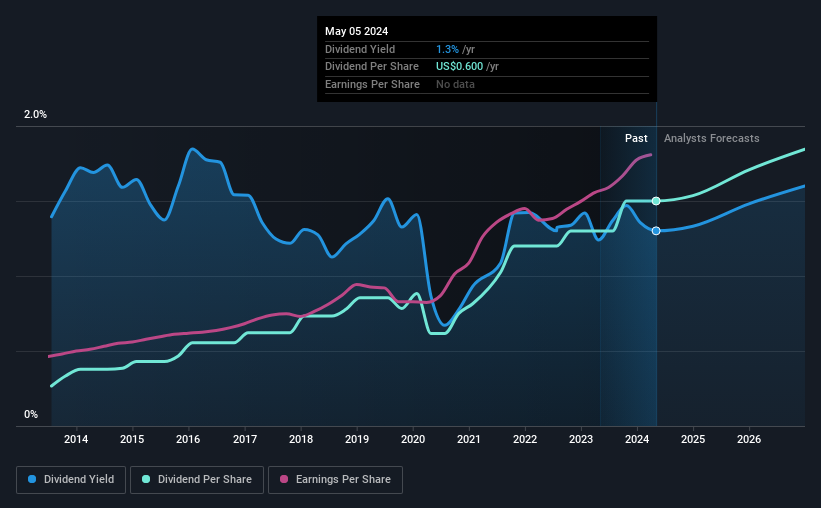Only Three Days Left To Cash In On Rollins' (NYSE:ROL) Dividend
Readers hoping to buy Rollins, Inc. (NYSE:ROL) for its dividend will need to make their move shortly, as the stock is about to trade ex-dividend. The ex-dividend date is one business day before a company's record date, which is the date on which the company determines which shareholders are entitled to receive a dividend. It is important to be aware of the ex-dividend date because any trade on the stock needs to have been settled on or before the record date. In other words, investors can purchase Rollins' shares before the 9th of May in order to be eligible for the dividend, which will be paid on the 10th of June.
The company's next dividend payment will be US$0.15 per share. Last year, in total, the company distributed US$0.60 to shareholders. Calculating the last year's worth of payments shows that Rollins has a trailing yield of 1.3% on the current share price of US$46.12. Dividends are an important source of income to many shareholders, but the health of the business is crucial to maintaining those dividends. We need to see whether the dividend is covered by earnings and if it's growing.
Check out our latest analysis for Rollins
Dividends are typically paid out of company income, so if a company pays out more than it earned, its dividend is usually at a higher risk of being cut. Rollins paid out 62% of its earnings to investors last year, a normal payout level for most businesses. A useful secondary check can be to evaluate whether Rollins generated enough free cash flow to afford its dividend. Dividends consumed 52% of the company's free cash flow last year, which is within a normal range for most dividend-paying organisations.
It's positive to see that Rollins's dividend is covered by both profits and cash flow, since this is generally a sign that the dividend is sustainable, and a lower payout ratio usually suggests a greater margin of safety before the dividend gets cut.
Click here to see the company's payout ratio, plus analyst estimates of its future dividends.
Have Earnings And Dividends Been Growing?
Businesses with strong growth prospects usually make the best dividend payers, because it's easier to grow dividends when earnings per share are improving. If business enters a downturn and the dividend is cut, the company could see its value fall precipitously. For this reason, we're glad to see Rollins's earnings per share have risen 14% per annum over the last five years. Rollins has an average payout ratio which suggests a balance between growing earnings and rewarding shareholders. This is a reasonable combination that could hint at some further dividend increases in the future.
Another key way to measure a company's dividend prospects is by measuring its historical rate of dividend growth. In the last 10 years, Rollins has lifted its dividend by approximately 19% a year on average. It's great to see earnings per share growing rapidly over several years, and dividends per share growing right along with it.
Final Takeaway
Has Rollins got what it takes to maintain its dividend payments? Higher earnings per share generally lead to higher dividends from dividend-paying stocks over the long run. That's why we're glad to see Rollins's earnings per share growing, although as we saw, the company is paying out more than half of its earnings and cashflow - 62% and 52% respectively. Overall, it's not a bad combination, but we feel that there are likely more attractive dividend prospects out there.
Curious what other investors think of Rollins? See what analysts are forecasting, with this visualisation of its historical and future estimated earnings and cash flow.
If you're in the market for strong dividend payers, we recommend checking our selection of top dividend stocks.
Have feedback on this article? Concerned about the content? Get in touch with us directly. Alternatively, email editorial-team (at) simplywallst.com.
This article by Simply Wall St is general in nature. We provide commentary based on historical data and analyst forecasts only using an unbiased methodology and our articles are not intended to be financial advice. It does not constitute a recommendation to buy or sell any stock, and does not take account of your objectives, or your financial situation. We aim to bring you long-term focused analysis driven by fundamental data. Note that our analysis may not factor in the latest price-sensitive company announcements or qualitative material. Simply Wall St has no position in any stocks mentioned.

 Yahoo Finance
Yahoo Finance 
